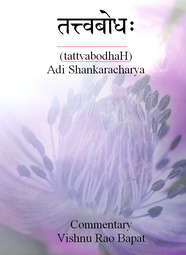
VEDĀNTA the solution to our fundamental problem by D. Venugopal
Part 44 begins the discussion on Ishvara and the ‘orders’ that govern the world-appearance.
There is a complete Contents List, to which links are added as each new part appears.


VEDĀNTA the solution to our fundamental problem by D. Venugopal
Part 44 begins the discussion on Ishvara and the ‘orders’ that govern the world-appearance.
There is a complete Contents List, to which links are added as each new part appears.

Part 29 of the commentary by Dr. VIshnu Bapat on Shankara’s Tattvabodha.This is a key work which introduces all of the key concepts of Advaita in a systematic manner.
The commentary is based upon those by several other authors, together with the audio lectures of Swami Paramarthananda. It includes word-by-word breakdown of the Sanskrit shloka-s so should be of interest to everyone, from complete beginners to advanced students.
Part 29 explains what happens to the j~nAnI and his accumualted karma on enlightenment.
There is a hyperlinked Contents List, which is updated as each new part is published.

VEDĀNTA the solution to our fundamental problem by D. Venugopal
Part 43 explains how every cognition is a mithyA superimposition of name and form upon the sat brahman.
There is a complete Contents List, to which links are added as each new part appears.

Part 28 of the commentary by Dr. VIshnu Bapat on Shankara’s Tattvabodha.This is a key work which introduces all of the key concepts of Advaita in a systematic manner.
The commentary is based upon those by several other authors, together with the audio lectures of Swami Paramarthananda. It includes word-by-word breakdown of the Sanskrit shloka-s so should be of interest to everyone, from complete beginners to advanced students.
Part 28 explains why saMchita and AgAmi karma are eradicated on the gaining of Self-knowledge.
There is a hyperlinked Contents List, which is updated as each new part is published.

VEDĀNTA the solution to our fundamental problem by D. Venugopal
Part 42 provides a detailed explanation of the of the pa~ncha kosha prakriyA – the ‘sheath’ metaphor from the Taittiriya Upanishad.
There is a complete Contents List, to which links are added as each new part appears.

Part 27 of the commentary by Dr. VIshnu Bapat on Shankara’s Tattvabodha.This is a key work which introduces all of the key concepts of Advaita in a systematic manner.
The commentary is based upon those by several other authors, together with the audio lectures of Swami Paramarthananda. It includes word-by-word breakdown of the Sanskrit shloka-s so should be of interest to everyone, from complete beginners to advanced students.
Part 27 looks at saMchita and prArabdha karma.
There is a hyperlinked Contents List, which is updated as each new part is published.

VEDĀNTA the solution to our fundamental problem by D. Venugopal
Part 41 analyses the status of brahman vis-a-vis the world and begins the description of the pa~ncha kosha prakriyA.
There is a complete Contents List, to which links are added as each new part appears.

Part 26 of the commentary by Dr. VIshnu Bapat on Shankara’s Tattvabodha.This is a key work which introduces all of the key concepts of Advaita in a systematic manner.
The commentary is based upon those by several other authors, together with the audio lectures of Swami Paramarthananda. It includes word-by-word breakdown of the Sanskrit shloka-s so should be of interest to everyone, from complete beginners to advanced students.
Part 26 begins the description of the types of action and their fruit in the form of the three karmas.
There is a hyperlinked Contents List, which is updated as each new part is published.
 (Read Part 14 of the series.)
(Read Part 14 of the series.)
Phenomenology and Existentialism
Phenomenology
This movement began in the late nineteenth century as a theory of knowledge that attempted to reinstate science and bring in the modern findings from psychology and sociology to supplant the subjectivity that had predominated until then with the German Idealists. In particularly the wish was to understand the nature of awareness, differentiating between mental and non-mental realms. Edmund Husserl, who was the teacher of Martin Heidegger (below), is generally credited with establishing the movement. It was acknowledged that we could not know that objects exist independent of our awareness of them but also that it cannot be denied that we are conscious of ‘things’. Phenomenology endeavoured to start from this point and attempt to analyse our experience without making any further assumptions. It subsequently merged into Existentialism.
Maurice Merleau-Ponty was particularly interested in perception and the nature of the perceiving entity and ‘object’ of perception. He disliked both the empiricist and idealist approaches and spent much of his time attacking all dualist concepts such as the mind-matter division of Descartes. There cannot be any totally objective perception of the world, he said, because our perceptual apparatus is itself part of the world. Whenever we see something, what we ‘see’ comes along with everything else that we already know and the perception itself is the sum total of all of this. We can never see a chair, for example, without the awareness of its purpose as something for sitting on. The origin of our belief in a separate world derives from our thinking of ‘ourselves’ as other than the body that we apparently inhabit. We are our bodies, he said, and the mind cannot be separated from them. Continue reading

VEDĀNTA the solution to our fundamental problem by D. Venugopal
Part 40 explains the distinction between the three orders of reality – paramArtha, vyavahAra and pratibhAsa.
There is a complete Contents List, to which links are added as each new part appears.